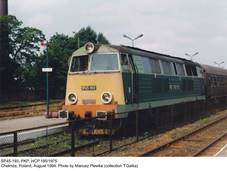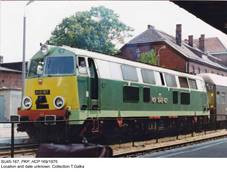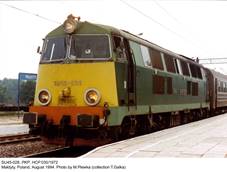SP45, SU45 and ST45
|
|||||||||||||||||||||||||||||||||||||||||||||||||||||||||||||||||||||||||||||||||||||
|
Had it not been for its hydraulic transmission, PKP need for a line passenger diesel locomotive might have been
satisfied by Austrian SGP 2020. Its
preserved prototype was photographed in Mistelbach
on September 5, 2020, by someone who wishes to be known as Linie29 (source: www.commons.wikimedia.org). Prototype SU45-001, location and date unknown. Despite the PKP logo, this locomotive was never
accepted by state railways and remained the manufacturer’s property. Photo
from my collection. Second example of the 12C22W engine on
display at the Snow-covered SP45-139 ( HCP
141/1974) at Kościerzyna depot, February 5, 2003. Another picture of the SP45-139, taken on September 23, 2013. This is
the only surviving example of the original variant with steam heating unit. SU45-208
( HCP 210/1975) photographed near Toruń
on June 18, 2003. Later modified and re-numbered ST45-14. SU45-082
(HCP 084/1973) at Toruń
Kluczyki depot, August 8, 2003. Scrapped in 2012. SU45-092
(HCP 094/1973) at Głogów station,
November 10, 2003. This locomotive has already been scrapped. Not
only steamers can be seen in Wolsztyn: SU45-048 (HCP 050/1972) was photographed there on April 30, 2005... ...
this SU45-195 (HCP 197/1975) almost one
year later, on April 29, 2006... ...and
SU45-202 (HCP 204/1975) on April 28,
2007. Another
picture of SU45-048, taken at the Leszno depot on July 26, 2006... ...and
of SU45-202: Rzepin depot, May 15, 2009. SU45-097 (HCP 099/1973) in Krotoszyn, November 26,
2003. SU45-111
(HCP 113/1974) near Sierpc, April 4,
2004. SP45
side drawings: prototype…. …
and late production variant (both drawings by M. Ćwikła
from the monograph quoted in references). Two
SU45s inside the engine shed in Ełk: SU45-137... ...
and SU45-244 (on the right – ST44-967); both photos taken on June 15, 2006. Two
more photos from Ełk: SU45-045... ...and
SU45-078; August 14, 2007. SU45-209,
photographed in Hajnówka on June 30, 2006. Many
SP45s and SU45s withdrawn from use could be seen at various depots in Poland
– you can see some of them here. SU45-250
emits a cloud of black smoke as her diesel engine is started; Korsze,
September 9, 2008. Two
more SU45s photographed in Korsze on the same occasion: SU45-078… …and
SU45-070. Here diesel locomotives take over eastbound passenger trains. Two
SU45s, photographed in Dęblin on January 24, 2009: SU45-159… …and
SU45-245. Korsze
again: SU45-183, August 15, 2009. SU45-241,
Poznań Główny station, September 28, 2010… …and
ST45-04 (rebuilt from SU45-240), June 11, 2011, location unknown; the
locomotive behind is EU07-172. Both photos by Michał Korfel (from my
collection). SU45-071,
photographed near Serock with a local train on April 26, 2004. Photo by Rafał
Roskosz (from my collection). Two
more photos from my collection by the same author: SU45-079, photographed
near Wierzchucin on the next day… …and
SU45-123, Bydgoszcz, September 2001. More
pictures from my collection. SP45-252 with a passenger train, Olsztyn, August
1992 (photo by M. Plewka). SU45-233,
Chełmża, August 1994, the same author… …SP45-193… …and
SU45-167, both photographed probably on the same occasion. SU45-118, Chojnice, August 26, 1998 (photo
by Rafał Roskosz). SU45-167,
location and date unknown. More
photos by this author: SU45-219, Leszno, August 22,
1998… …SU45-133,
Szczecinek, June 23, 1998… …and
SU45-188, photographed on the same occasion. SP45-142, Kamieniec Ząbkowicki depot, May 3, 1997. SU45-225, Zbąszynek, August 21, 1998 (photo
by Rafał Roskosz). SU45-214, Kędzierzyn-Koźle, April
1998 (photo by M. Plewka). Two
more pictures by the same author: SU45-023, Czeremcha
depot, May 10, 2000… …and
SU45-028, Małdyty, August 1994. SU45-006,
location unknown, August 1994. SU45-210,
Grudziądz depot, November 19, 2009. Photo by Sławomir Fedorowicz (from my
collection). The
same author, location and date: ST45-02 (rebuilt SU45-238), operated by PKP Cargo. SU45-052, Jaworzyna Śląska, July
8, 1998. Photo by Marek Niemiec (from my collection).
This
locomotive still remains in the PKP Cargo rosters. SU45-064
(HCP 066/1973), photographed
in Kędzierzyn Koźle on
May 3, 1997. Photo by Mariusz Plewka
(used by permission). This locomotive still remains in use with Przewozy Regionalne. SP45-012,
photographed in Poznań in June 1984. This
locomotive (HCP
014/1971) was not rebuilt to the SU45 standard and has already been scrapped.
Photo from my collection. SP45-045,
PKP (HCP 047/1972), Toruń, July or August 1991… …and
SU45-138, PKP
(HCP 140/1974), Elbląg, August 1994. Both pictures by Mariusz
Plewka (used by permission). SP45-045, rebuilt into
SU45-045, was scrapped in Warsaw in December 2011; SU45-138 has also been
withdrawn – date unknown. SU45-054,
photographed near Chruściel on August 9, 2003.
Photo by Martin Stertz (from my collection). This
locomotive is currently (February 2023) owned by Polregio. SU45-263
(HCP 265/1976), location and
date unknown. In August 2011 this locomotive was rebuilt and re-numbered
ST45-05; it is still owned by PKP Cargo. Photo by Henryk
Magoń (postcard from my collection). One
more picture by Mariusz Plewka:
SU45-070 (HCP
072/1973) and SU45-162 (HCP 164/1975), Chełmża, August
1994. Both these locomotives have already been withdrawn. Used by permission. |
Orders for steam locomotives in Poland were terminated
in 1957 (although last steam engines were purchased six years later, but
that’s a different story). Soon it became obvious that, despite considerable
progress in electrification, large numbers of diesel locomotives would be
needed. Fablok works of Chrzanów,
then the sole manufacturer of such vehicles in Poland, had managed to supply
only light and medium switchers, not suitable for line service. Development
of new and much more powerful engines was obviously necessary. In 1961,
Austrian SGP (Simmering-Graz-Pauker)
2020.01 prototype with two 1100 hp diesels was
briefly tested by PKP, but license
production of this machine, fitted with hydraulic transmission, was out of
question. It was thus decided to develop an indigenous design and in 1965
this task was entrusted to Cegielski works
of Poznań (HCP),
who had no experience with heavy diesel locomotives, although a number of
railway and marine diesel engines had been built there. New locomotive was
intended for both passenger and freight trains, although the former would
obviously take priority (contracts for first ST43 freighters from Romanian Electroputere works were signed in June 1964). The prime mover was developed by the CBKSS (Central Design Bureau for
Internal Combustion Engines) on the basis of successful 8C22
eight-cylinder 800 hp unit, designed for SM42
switcher. By adding four cylinders and with higher supercharging the new powerplant, designated 12C22W, was intended to develop
1700 hp at 1100 rpm. In order to maintain moderate
axle load, Co’Co’ arrangement was chosen for the new
locomotive, initially designated SU44 (factory designation 301D). Bench running of the 12C22W started in April 1966
and was plagued by crankshaft and bearings failures (although some earlier
sources claim that he engine performed very well!). Soon rated power was
reduced to 1520 hp at 1020 rpm, some modifications
were introduced and in this version the engine was fitted to the prototype
locomotive. Development problems, however, delayed the whole program and
tests began only in August 1967 (due to this delay, the new loco became SU45,
first ST44s having been put into service in 1965). SU45-001 was never
accepted by PKP, remained the HCP property and was used for tests
only, to be finally scrapped in mid-1970s. Despite reduced engine output,
performance was found basically adequate, but the 12C22W proved very
unreliable and its development was finally cancelled. As alternative CT19
family of medium-speed diesels had been abandoned at an early stage, foreign
license seemed the only way to save the project. In fact, as early as in
November 1966 an agreement had been signed with FIAT Grandi
Motori of Turin, Italy, to produce at HCP their 2112SSF engine (1700 hp at 1500 rpm), then still under development. 2112SSF
was smaller than the Polish diesel, having the capacity of 95.5 litres (123.1 litres in 12C22W)
and was lighter by about 900 kg. Specific fuel consumption was, however,
almost the same (assuming initial rating of the Polish engine). In the meantime, it was decided that the new
locomotive should be produced in two variants: passenger SP45 with steam
car-heating device and freight ST45 (which materialized, in the form of a
SP45 conversion, only in 2009). Second prototype, designated SP45-002 (type
301Da), with imported FIAT engine,
was completed in June 1968. After prolonged tests it was accepted by PKP in 1971 and later re-designated
SP45-500 to avoid confusion with the standard production variant. FIAT-engined
SP45 was finally ordered by PKP
after several modifications, concerning mainly electric equipment and many minor
details (factory type 301Db). First production example, SP45-001 (HCP 003/1971), was rolled out in July
1971 and, until September 1976, 265 locomotives were delivered to PKP. Three
more followed in 1977 for Lebanese railways Chemins de fer l’Etat
Libanais (type 301Dc, HCP 301/1977 through 303/1977, CEL service numbers 1201 through 1203), with modified cooling
systems and many other minor changes. 301Dc was by some 8 tonnes
lighter than the original version. All three examples remained operational
until 1997. After almost twenty years of oblivion they were discovered in a
military base in Beirut. CEL plans
to purchase further ten examples failed to materialize. SP45 soon became the principal passenger diesel
locomotive in the PKP service.
Prior to its introduction, passenger trains on main unelectrified
trunk lines were often hauled by ST43 or ST44 freighters, which called for
additional heating cars during winter. Double-heading SN61 diesel railcars
(often supplemented by a third unit!) were too weak and their mechanical
transmission was prone to failure. Quite often steam locomotives had to be
employed, much to the concern of certain officials, who considered them a
symbol of backwardness. SP45s were therefore badly needed and soon could be
encountered on most principal unelectrified lines;
last SN61s were withdrawn from long-range service in 1974. During its production period, SP45 underwent
numerous modifications, aimed both at replacing imported elements and
sub-assemblies with their indigenous or license-built variants and at
improving reliability and safety. Basic characteristics and external
appearance were not affected. In mid-1980s, however, problems with imported Vapor
OK-4616 boilers for car heating became acute. Purchase of spares was costly
and steam-heated passenger cars rapidly dwindled in number. It was thus
decided to introduce 3000 V DC electric heating, with the Dolmel LCPb-400 generator
driven directly by the diesel engine, the same as in SU46 and SP47.
Modernization of the first example, SP45-074, was completed in January 1988,
and 190 more followed, terminating with SP45-061 in September 1997. In 1992
designation was changed to SU45, but service numbers were retained (SP45-090,
-095 and -099 retained their original designations despite being fitted with
electric heating devices). On January 1, 1999, PKP had only four machines with Vapor boilers (SP45-086, -139, -158 and -252) and all of them
were written off during that year. Electric heating reduced available
tractive effort and it was not uncommon to switch it off on long steep
slopes, in order to maintain scheduled speed. An interesting episode in the SU45 history was the
service of these locomotives with passenger trains from Gdynia to Kaliningrad
in Russia, started in early 1990s (1435 mm track extends to the Kaliningrad
passenger station). In 2004, however, this service was taken over by Russian
M62s and Polish locomotives later ran only to the border station of Mamonovo. Of 266 examples supplied to PKP, 161 still remained on the company’s rosters in 2004,
although not all of them were serviceable. According to detailed lists quoted
in KMD vol. 1/2010, in late 2009 three companies that had emerged from
PKP had in all 120 SU45s (PKP Cargo – 50, Przewozy
Regionalne – 51 and PKP InterCity – 19),
of which only 36 were in use (fourteen, seventeen and five, respectively).
For a long time they had been, together with their more powerful development,
SU46, the only heavy diesel locomotives in regular passenger traffic. Later,
with introduction of more economical railcars, they became surplus and many
were withdrawn from use, although not written off. Until April 2012 the
number of operational SU45s with all three operators dwindled to a mere
twelve examples and in mid-2015 only five were still in use. The last one of
them, SU45-079 (HCP 081/1973),
owned by Przewozy Regionalne,
suffered engine failure in January 2017 and was sold in December 2018 to ALS company of Stary
Sącz, together with SU45-089. This company is owned
by two railway enthusiasts who decided to restore SU45-079 in service as a
heritage locomotive; the other example was cannibalized for spares. First
test runs took place in February 2022. Original green livery has been
restored. In 2012 two withdrawn locomotives of this type
(SU45-141 and SU45-165) were purchased by Unikol
Railway Workshop, a private-owned company based in Kostrzyn,
for overhaul and further resale. SU45-141, re-designated 301Db-141, was sold
to WAM – a small private operator
based in Kamieniec Ząbkowicki.
Later it was returned to Unikol and in 2015 leased to Euronaft Trzebinia (re-numbered 301Db-143, in
accordance with its factory number). In June 2017 this locomotive was finally
transferred to Orlen KolTrans. SU45-165
still remains a Unikol
property and has served as a source of spare parts for 301Db-143. In
September 2014 nine surplus SU45s were offered for sale by PKP InterCity. All were eventually
sold in January 2016 to Karpiel Sp. z o. o. forwarding
company. Only one of them, SU45-192 (incorrectly re-numbered SU45-194) has
been overhauled and restored in service with its new owner. Initially modernization
of these locomotives had been intended, but this failed to materialize. They are
stored in Brzesko, in rather poor condition. SU45-115
(HCP 117/1974) was sold to SKPL company, but saw very little
service. Reportedly it is currently is awaiting a replacement diesel engine. A
the time of writing (February 2023) four examples are owned by PKP Cargo and other four by Polregio
(formerly PKP Przewozy
Regionalne), but most probably no longer remain
in use. Contrary to previously prevailing practice in Poland,
someone must have thought of the future demise of this class and SP45-139 (HCP 141/1974), written off in July
1999, was transferred to the rolling stock heritage park at Kościerzyna locomotive depot in October 2001. Currently
it remains there on a static display and is the only surviving example of the
original version with the Vapor
boiler for car heating. Thus, in all, 23 locomotives of this type still
exist. In late 1990s a modification program for principal
line passenger diesel locomotives (SU45 and SU46) was contemplated. Initially
it was intended to keep sixty SU45s in operation, but with obsolete FIAT
diesel engines replaced by new, modern units of unspecified type. This
operation was to have been completed until 2010, but the project saw fruition
only in 2009, in the form of the ST45-01. This is a conversion of SU45-112 (HCP
114/1974), which has been fitted with the MTU 12V4000R43 diesel
engine, de-rated to 1770 hp in order to match
electric traction engines, and state-of-the-art control systems. Crew
compartment has been completely redesigned and car heating equipment removed,
as ST45 is intended solely for freight traffic. The conversion was made by PESA
company of Bydgoszcz and ‘new’ locomotive (factory type 301Dd) was accepted
by PKP Cargo in June 2009. Externally – apart from navy blue livery –
it can be easily distinguished by rectangular headlights. Modernization
program was intended to be completed in two years and include twenty SU45s.
Three more examples followed until March 2010: ST45-02 (ex SU45-238), ST45-03
(SU45-254) and ST45-04 (SU45-240). Deliveries were resumed in September 2011,
but totaled only nineteen locomotives, the last one (ST45-19, ex SU45-156, HCP 158/1975) being delivered in
October 2012. ST45s are based in Katowice, Lublin and Gdynia depots. Despite
initial success, ST45 was finally judged too weak for many tasks, especially
compared to re-engined SM48 and ST44 from Newag and Pesa,
respectively. Four oldest examples were withdrawn from use until October
2017; further withdrawals followed suit. The last one, ST45-19, was withdrawn
in October 2020. All nineteen locomotives of this type still remain in the
company’s rosters, but their future is unclear.
Main
technical data
1)
Supplanted by 3000 V electric heating in the 1980s (designation
changed to SU45). 2)
12C22W of the same rating in the prototype, MTU
12V4000 R43 1770 hp (1300 kW) in ST45. 3)
301D prototype. 4)
Type 301D, 108 000 kg ; 301Dc, 96 000 kg; 301Dd, 97 000
kg. 5)
Type 301D, 18.0 T; 301Dc, 16.0 T; 301 Dd, 16.3 T. References
and acknowledgments
-
HCP Diesel Locomotives, Classes SP45, SU46, SP47
by Marek Ćwikła and Paweł Terczyński (Kolpress,
2004, in Polish); -
Article on the ST45 conversion by Paweł Terczyński (SK
vol. 10/2009); -
Article
by Paweł Czech (KMD vol. 1/2010); -
AL, SK, SS (various issues); - Article by Wojciech Kamiński (SS
vol. 2/2012); - www.kolejowaklatka.org
(website by Marek Dąbrowski). |
||||||||||||||||||||||||||||||||||||||||||||||||||||||||||||||||||||||||||||||||||||

























































